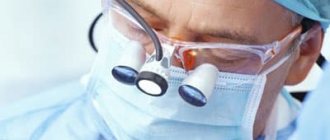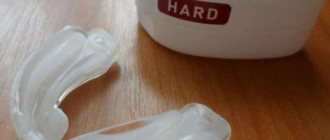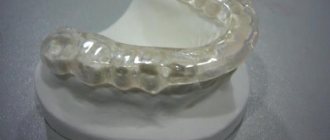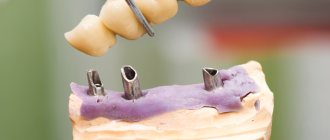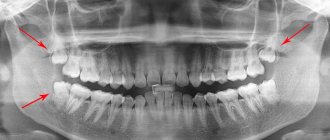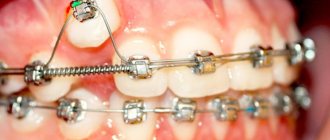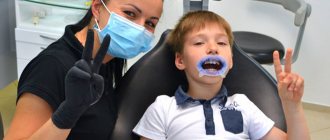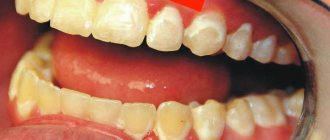If you have a sore throat, a stuffy nose, and a general feeling of malaise, then these are obvious symptoms of a cold. What to do if you have an appointment with the dentist at this time - is it possible to treat teeth if you have a cold? It is impossible to answer this question unequivocally, since most often it is better to postpone a dental appointment until recovery.
Is it safe to treat your teeth when you are sick?
Most dentists are inclined to think that a visit to a doctor should be made in a healthy state, that is, without any ailments. Some doctors even advise postponing a visit to the dentist during an exacerbation of chronic diseases such as gastritis, colitis, dermatitis, etc.
The fact is that during an illness, a person’s immunity is subject to a heavy load: he has to not only cope with the infectious agent, but also take care of restoring the normal functioning of the body.
At the same time, some methods of dental treatment, for example, anesthesia, depulpation, tooth extraction (extraction), etc., also put a strain on the body’s defenses. There is no need to overstrain your immune system.
Indications for tooth extraction
Extirpation is done when therapeutic treatment is impossible or before prosthetics. It can be planned or emergency. It is carried out using a simple or complex method. In the first case, the dental unit is removed from the socket using forceps, and in the second, dissection of the gums, alveolar bone, and sawing of the roots into fragments may be required.
Indications for emergency surgery:
- the presence of purulent inflammation, fistula, cyst;
- acute pain that is not relieved by medication;
- fracture of the crown, root.
Planned extraction is done if:
- advanced caries, if the area of the carious cavity of the crown is more than 70 percent, the pathology has spread to the root part;
- pulpitis in a complex root system, when it is impossible to properly clean the canals (usually in a figure eight);
- periodontitis with stage 3 or 4 mobility;
- third molars that interfere with neighboring ones cause changes in bite, facial asymmetry, neurological pain, pericoronitis;
- supernumerary, dystopic, impacted teeth, which cause various disorders in the dental system;
- orthodontic indications for prosthetics, installation of braces.
Experienced dentists always strive to preserve the integrity of the dentition, so radical measures are usually taken in the absence of a positive result of therapeutic treatment. After the procedure and recovery period, acute pain goes away, but chewing function worsens when removing molars or aesthetics when extracting incisors or canines.
Do cold symptoms – runny nose, cough, fever – affect treatment?
Manifestations of a cold or viral disease in the form of a stuffy nose, cough, sore throat, low-grade fever in themselves cause discomfort. But in the dentist's chair it will increase several times, because you will have to sit motionless, with your head thrown back, for a long time. And at the same time breathing through your nose, which will be difficult with a runny nose. In addition, it will be difficult for the doctor to carry out manipulations if the patient has a severe cough.
“Girls, never treat your teeth when you have a runny nose! Even if you put drops in your nose before taking it. Breathing through your nose is not the main problem. The main thing will begin later in the form of gumboil. Didn’t want to postpone your treatment date by a week because of a runny nose? Get two weeks of gumboil, a course of antibiotics, drainage of pus from the gums and all 33 pleasures. It almost didn’t come to the point of surgery.”
Post by user NataPustova from the ladycity.ru forum
Even if there is no runny nose or cough, but the temperature is elevated, dentists do not recommend dental treatment on such a day. The fact is that an increase in temperature is the body’s protective response to the presence of any virus or bacteria, so an extra load on the immune system in the form of stress and drugs used by the doctor in dental treatment is undesirable. In addition, tissue regeneration during such a period is reduced, which means that after visiting the dentist there may be complications: long-term persistence of the pain effect, poor blood clotting, incorrect reaction to anesthesia.
Important! If the increase in temperature is not caused by ARVI, but by an inflammatory process in the oral cavity (for example, inflammation of the gums, gumboil, cyst formation, etc.), then treatment should be carried out immediately. This condition can lead to more serious complications, so doctors advise not to delay your visit to the clinic.
Stages of the procedure
Simple extirpation is carried out using forceps, consisting of cheeks, a handle, and a lock. It is performed if the coronal part is well preserved and there are no various complications. Incisors and canines on the upper jaw are removed with straight forceps, on the lower jaw - curved at an angle of 90 degrees. S-shaped instruments are used to extract premolars and molars.
Removing an upper wisdom tooth is easier than on the lower jaw, since it has an even, small root, so a simple operation is performed if there are no complications. The lower jaw bone is denser and more massive, and the root part of the figure eight is complex.
A simple extraction consists of several steps:
- local anesthesia;
- antiseptic treatment;
- application of forceps followed by advancement of the cheeks under the gums and fixation;
- rocking, dislocation and extraction of a dental unit from the socket.
Complex extirpation requires the use of several different instruments, takes a longer time, injures nearby tissues, is dangerous for complications, and the rehabilitation process lasts longer. Pain relief during tooth extraction, especially eights, can be general. The surgeon uses a scalpel or laser, drill, elevator, excavator, and other instruments.
Step-by-step complex removal:
- local or general anesthesia;
- antiseptic treatment;
- dissection of the gums, separation of the flap from dental and bone tissues;
- if necessary, drilling or cutting off part of the bone, dividing the root into several fragments;
- extraction of a dental unit in whole or in parts;
- bleeding stop;
- application of antibacterial and anti-inflammatory drugs;
- suturing the gum.
To stitch soft tissues, self-absorbing or non-absorbable threads are used, which are removed after 7-10 days.
Is it possible to remove a tooth during ARVI?
Surgeons, as a rule, do not advise a patient to remove teeth if he has symptoms of ARVI. The risk of infection of an open wound during such manipulation is very high. Even the immune system of a healthy person sometimes fails to protect itself, and complications arise. And if the immune system is loaded with the fight against the virus, then this is an almost one hundred percent guarantee of the development of complications after surgery.
Attention! Tooth extraction during a respiratory viral disease is possible only for health reasons. In this case, the surgeon must thoroughly disinfect the entire oral mucosa and surface of the teeth, as well as the patient’s lips. After removal, he treats the wound itself with antiseptic drugs, and the patient is prescribed a course of antibiotics and drugs that strengthen the immune system. It is recommended to adhere to the schedule for taking such medications throughout the entire course of treatment.
Means of protection
Medical masks are reliable protection during dental procedures that do not require the use of devices that create an air-aerosol suspension. This is explained by the fact that viruses themselves do not fly through the air; they need drops of moisture to do this. This means that the patient, even if he is a carrier of the infection, does not pose a threat to the doctor. For large droplets formed when sneezing or coughing, a medical mask is always reliable protection. Taking into account all the safety measures taken in dental clinics, in this case, the spread of infection does not occur.
The doctor provides more guaranteed protection for himself if he uses specialized masks with an inhalation valve. This protection works effectively throughout the entire shift. The degree of protection increases if you additionally use glasses. But this poses certain dangers for the patient if the doctor is a carrier of the virus.
Is it possible to treat teeth if a “cold” appears on the lip?
The appearance of herpes on the lip (or, as it is called in everyday life, a “cold”) itself is rarely accompanied by malaise, fever or other symptoms. However, if a painful blister appears on the lip, this means that the body’s immunity is weakened and it does not have enough strength to contain the virus. In such cases, patients are advised to first cure herpes and take care of supporting the immune system.
In addition, the herpes virus is also dangerous because it can get from the lip through instruments to open areas: wounds on the gums or nerve canals of the tooth. This will lead to complications of treatment - stomatitis, suppuration in soft tissues, etc.
Features of anesthesia in children in dentistry
When treating a child, the primary role is played by his psycho-emotional state, so the choice of pain relief method is very important. If he is not psychologically prepared and is afraid, then even a simple procedure becomes a serious problem. Because of the baby’s anxiety and resistance, the doctor cannot concentrate, the parents become irritated and tired, and the time drags on with persuasion.
Problems of pain management in childhood:
- frequent development of allergies to local anesthetics;
- fear of medical instruments, including syringes, needles;
- many drugs are prohibited at an early age (up to 4 years);
- the anesthesiologist must clearly calculate the dosage.
If there are contraindications to anesthetics, the child cannot be persuaded or calmed down, then the procedures should be carried out only with the use of sedatives.
Otherwise, fear of the dentist can remain for life, interfere with maintaining the health of the dental system, and lead to tooth decay and loss.
Types of anesthesia in pediatric dentistry:
- local is the most common technique, which is usually carried out in two stages: first, an anesthetic spray or gel is used, and then an injection is given;
- general - carried out strictly according to indications;
- sedation - does not exclude the use of local anesthetics, but allows the child to relax.
The doctor chooses the type of anesthesia (drug, method of administration) only after a thorough diagnosis and exclusion of contraindications.
In what cases is it acceptable to treat teeth during a cold?
Dental treatment for ARVI is not recommended, but there are cases when you cannot postpone a visit to the doctor. The most striking example is the risk of periostitis (flux).
Periostitis is a purulent inflammation of the periosteum, which can provoke the development of more serious diseases. Infection of the periosteum can develop against the background of hypothermia and ARVI, acute periodontitis or pulpitis. In this case, treatment must begin immediately, before the formation of a purulent sac, otherwise intoxication of the body cannot be avoided.
Worth remembering! Sometimes painful sensations in a damaged or previously filled tooth can occur against the background of a cold and fever. As a rule, pain and discomfort go away after 3-4 days, as soon as the cold symptoms disappear.
How to help yourself at home
A cold does not mean that you have to wait for recovery and endure toothache. To get rid of unpleasant sensations and minimize the likelihood of complications, you should:
- Do not ignore the requirements for careful hygiene of teeth and gums. Even if you feel unwell, you need to brush your teeth twice a day, and after each meal or sweet drink, rinse your mouth with clean water.
- Take symptomatic medications that are used for ARVI, as they contain painkillers that will help eliminate pain.
Try not to chew hard food on the side of the diseased tooth until you go to the dentist; it is better to switch to soft food for a while.
Complications after dental treatment during a cold
Viruses most often enter the body through the mucous membrane of the throat or nose, so these tissues are the first to become inflamed. The proximity of the infected area to the treatment site increases the risk of the virus entering the tooth tissue, for example, along with saliva. This can not only slow down recovery after manipulation, but also cause complications:
- sinusitis: if a virus or bacteria enters the maxillary sinuses. This disease is very dangerous because a large amount of pus forms in the sinuses close to the eyes and brain, which leads to intoxication,
- Otitis media: If an infection enters the inner or middle ear and causes inflammation. Severe otitis media can lead to hearing loss,
- pneumonia: if the infection enters the respiratory tract, inflammation will begin in the lungs. Treatment of pneumonia is very long, and if it is started untimely, the risk of death increases,
- meningitis: viruses or bacteria enter the brain through the circulatory system, causing inflammation of its membranes. This disease is characterized by high mortality,
- osteomyelitis: when the infection spreads through the bloodstream or infected surrounding tissue to the bone tissue. The course of the disease is such that it leads to bone deformation or degeneration.
Sedation is an alternative to general anesthesia
If anesthesia is contraindicated or inappropriate, but the child cannot be persuaded to undergo dental treatment, then sedation is used. It comes in two types: inhalation with nitrous oxide or intravenous with Propofol or Dexdor.
In the first case, the child inhales the vapors of “laughing gas” and relaxes, plunging into a pleasant state of half-asleep. He remains conscious and can hear and comply with the doctor's requests. This does not exclude local anesthesia. Nitrous oxide is harmless to the body. Its effect begins immediately after the gas is supplied and stops just as quickly. The procedure is performed on babies, older children and even adults.
Intravenous sedation can be superficial, moderate, or deep. This depends on the dosage of the drug. After the drug is administered, the child’s consciousness is not suppressed, as with anesthesia, but he does not respond to treatment, as he sleeps.
Consumer reviews about Asepta Active mouthwash
julia-06 (irecommend.ru):
“A very good rinse for problem gums.
She had never encountered the problem of bleeding gums, but at her next visit to the dentist she noticed that when she only lightly touched her gums, they began to bleed. So the dentist gave me a mini version of Paradontax toothpaste and advised me to use a mouthwash after brushing my teeth. Mom bought Asepta active mouth rinse.
For some reason I used to be very skeptical about such remedies, but as it turned out, in practice it helps very well. My problem went away completely, my gums stopped bleeding. I don’t even want to read the ingredients and go into its details, it’s unlikely that everything is super natural, but since it helps, I give the mouthwash a solid 5 points. Of course, each case is individual, but I will recommend it based on my experience. And the price of the rinse aid is quite reasonable.”
Ekaterina773 (irecommend.ru):
“I use Asepta mouthwash in combination with toothpaste and gel from the same company. My dentist recommended it to me, and I highly recommend it to you! My gums stopped bleeding after the second use. The mouthwash, unlike the paste, has an astringent effect, and makes the tongue a little numb. It costs around 150 rubles, but exceeds this money 1000 times.”
Sources:
- The role of anti-inflammatory rinse in the treatment of periodontal diseases (L.Yu. Orekhova, A.A. Leontyev, S.B. Ulitovsky) L.Yu. OREKHOVA, Doctor of Medical Sciences, Prof., Head of Department; A.A. LEONTIEV, dentist; S.B. ULITOVSKY, Doctor of Medical Sciences, Prof. Department of Therapeutic Dentistry of St. Petersburg State Medical University named after. acad. I. P. Pavlova
- Report on clinical trials of anti-inflammatory balm for gums "Asepta" adhesive, St. Petersburg State Medical University, 2007
- Report on determining/confirming the preventive properties of commercially produced personal oral hygiene products: Asepta toothpaste used in combination with Asepta mouthwash and Asepta gum balm Head. Department of PFS Doctor of Medical Sciences Professor S.B. Ulitovsky St. Petersburg State Medical University named after Academician I.P. Pavlova. Faculty of Dentistry. Department of Preventive Dentistry.
How to calculate the time of the visit?
Preventative examination and consultation usually take no more than 20-30 minutes. If you are seeking comprehensive teeth cleaning, tartar removal, or caries treatment, the appointment time will be 1 hour. If complex treatment is needed, the dose can be extended to 2 hours. Longer procedures (for example, dental prosthetics) are agreed upon by the doctor and the patient in advance.
If you are visiting the clinic for the first time and your card is not there, you should come 15-20 minutes before your appointment. During this time, the administrator will issue a card and enter all your data into it. You need to have your passport with you.
The treatment of many diseases requires several repeated visits to the dentist, and the intervals between them are determined by the doctor (they may depend on the effect of the medications used, healing time, etc.). If you are planning serious treatment, it is better to choose a period when you can freely manage your time and visit the doctor frequently.
Possible complications
Wisdom tooth removal is one of the most difficult operations in dentistry. Therefore, after it is carried out, various complications cannot be excluded. Thus, during the operation, neighboring “sevens” are sometimes damaged. Such severe consequences are the result of incorrectly chosen treatment tactics, as well as the low qualifications of the dentist, who was unable to understand the peculiarities of the patient’s anatomical structure.
Mature patients in some cases experience damage to the nervous system and, as a result, impaired sensitivity and numbness. Young patients encounter such disorders much less frequently.
A few hours after the removal of a wisdom tooth, bleeding may develop, which is most often provoked by intense rinsing, irritating the wound with the tongue, or eating hot food. This disorder is especially dangerous for patients suffering from hypertension and bleeding disorders.
Dry socket is the most common postoperative complication. Normally, after a wisdom tooth is removed, a blood clot forms in the socket, which promotes rapid healing of the wound. Sometimes a clot does not form, most often in smokers. After a few days, acute pain may appear, for which you should definitely consult a doctor.
